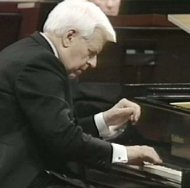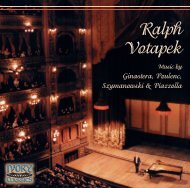70805 for PDF 11/05 - Ivory Classics
70805 for PDF 11/05 - Ivory Classics
70805 for PDF 11/05 - Ivory Classics
Create successful ePaper yourself
Turn your PDF publications into a flip-book with our unique Google optimized e-Paper software.
Earl Wild Plays Spanish and French Gems<br />
Music by Albéniz, Debussy, Falla, Granados, Mompou, Moszkowski and Ravel<br />
Manuel de Falla (1876-1946)<br />
n Danza del molinero (“Miller’s Dance”)<br />
from El sombrero de tres picos (“Three<br />
Cornered Hat”)<br />
n Danza ritual del fuego (“Ritual Fire<br />
Dance”) from El amor brujo<br />
Commenting on Spanish music, and<br />
his own contributions to it in particular,<br />
Manuel de Falla once stated, “Our music<br />
must be based on the natural music of our<br />
people, on the dances and songs that do<br />
not always show close kinship… It has<br />
occasionally been asserted that we have<br />
no traditions. We have, it is true, no written<br />
traditions; but in our dance and our<br />
rhythm we possess the strongest traditions<br />
that none can obliterate. We have the<br />
ancient modes which, by virtue of their<br />
extraordinary inherent freedom, we can<br />
use as inspiration dictates.”<br />
Manuel de Falla was born in Cadiz,<br />
Manuel de Falla<br />
Spain, November 23, 1876. After preliminary<br />
studies with his mother and several<br />
local teachers, Falla entered the Madrid Conservatory. There he was profoundly<br />
influenced by two teachers, the composer Felipe Pedrell and the pianist José Tragó.<br />
He graduated from the Conservatory with highest honors and in 19<strong>05</strong> won first prize<br />
<strong>for</strong> La Vida Breve, in a competition among Spanish composers sponsored by the<br />
Academy of Fine Arts in Madrid. He visited Paris in 1907 and was so intoxicated<br />
by its musical life that he spent the next seven years in that grand city. There<br />
– 2 –
he met Debussy, Dukas, Ravel, Fauré, Satie, Schmitt and Roussel. Upon his<br />
return to Spain in 1914 he embarked on an extensive tour, eventually settling in<br />
Granada. He composed El Amor Brujo in 1915, and one year later, the Nights in the<br />
Gardens of Spain. As a result of a commission by Serge Diaghilev, Falla composed<br />
“The Three Cornered Hat,” which became one of the most successful ballets produced<br />
by the Ballet Russe. During the Spanish Civil War, Falla, who was intensely<br />
religious, allied himself with the Franco <strong>for</strong>ces. He saw in the nationalist movement<br />
a balance to the anti-religious activities that had been taking place throughout<br />
Spain. However, support eventually gave way to disenchantment, and Falla, in ailing<br />
health, chose to expatriate himself. Falla died in Alta Garcia, in the province of<br />
Córdoba, Argentina, on November 14, 1946.<br />
The Danza del molinero (“Miller’s Dance”) is one of Falla’s most enchanting and<br />
popular pieces. It is the sixth section of the ballet El sombrero de tres picos (“The<br />
Three Cornered Hat”). The story <strong>for</strong> this ballet is a simple one. A young miller’s wife<br />
attracts the lusty attentions of the local Governor, who, in order to assure the success<br />
of his advances, jails the miller. The miller’s wife entices the Governor with a<br />
seductive dance to a nearby bridge where due to his excitement he tumbles into the<br />
water. Surviving the fall he goes to the miller’s house to dry himself and taking off<br />
his clothes he makes himself at home in the miller’s bed. To revenge himself, the<br />
freed miller steals the Governor’s clothes. The Miller’s Dance is a fiery farrucca (a<br />
Spanish flamenco dance of gypsy origin). Falla’s ballet was first per<strong>for</strong>med at the<br />
Alhambra Theatre in London on July 22, 1919 with choreography by Leonide<br />
Massine. The curtain, scenery, and costumes of the Russian Ballet’s production were<br />
all designed by none other than Picasso.<br />
Manuel de Falla composed El Amor Brujo in 1915 <strong>for</strong> a gypsy singer and dancer<br />
named Pastora Imperio, whose mother had told the librettist, Martínez Sierra, the<br />
story on which he built his scenario. It is the story of Candelas, a gypsy girl of passionate<br />
propensities, who was once in love with an evil but irresistible man who<br />
died a violent death. Her new lover, named Carmelo, is much more worthy of her<br />
love. But Candelas is superstitious, and every time Carmelo draws near she feels the<br />
ghostly presence of her departed lover and shrinks away in fear and trembling.<br />
Carmelo, who knew the dead man, reasons that the specter must be attacked at its<br />
weakest point. The dead man had been jealous, but he had also been unfaithful.<br />
– 3 –
Ingeniously, then, Carmelo induces a<br />
pretty acquaintance of Candelas’, whose<br />
name is Lucia, to make advances to the<br />
apparition when it next appears. The<br />
ruse works. In the few minutes that the<br />
ghost’s attentions are thus directed,<br />
Carmelo takes Candelas in his arms —<br />
the spell is broken — life triumphs over<br />
death. The Ritual Fire Dance is actually<br />
titled Ritual Dance of Fire <strong>for</strong> the<br />
Exorcism of Evil Spirits. It is one Falla’s<br />
most astonishing and popular musical<br />
creations, evoking a smoking cauldron<br />
and demonic incantations.<br />
Isaac Albéniz (1860-1909)<br />
n2 Malagueña from España, Opus 165<br />
n3 Castilla (Seguidillas) from Suite española,<br />
Opus 47<br />
n5 Triana from Iberia, Book 2<br />
Isaac Albéniz began his career as a<br />
touring virtuoso pianist. Appearing on the<br />
Isaac Albéniz<br />
concert plat<strong>for</strong>m at the age of four, his<br />
early life was highly colorful and adventurous.<br />
After being refused admittance to the Paris Conservatory on the grounds that<br />
he was much too young, he ran away from home at the age of nine. He gave concerts<br />
all over Spain, earning enough money to travel to the New World. After<br />
working his way from Cuba to San Francisco playing the piano, he eventually<br />
returned to Europe when he was thirteen. Studies in England and Germany preceded<br />
his return to Spain where he received a Royal grant to continue his travels.<br />
A few years later he gave up his life as a touring piano virtuoso, though not be<strong>for</strong>e<br />
he had concertized once again throughout the Americas. He then went to Paris to<br />
– 4 –
study with Dukas, Debussy and d’Indy. He also met Franz Liszt, and toured briefly<br />
with Anton Rubinstein. When Albéniz abandoned his role of wandering virtuoso, he<br />
dedicated the rest of his life to composition. In 1899, his first and most important<br />
orchestral work appeared, Catalonia, a rhapsody celebrating the place of his birth.<br />
Two years later he composed his masterpiece, Iberia. His remaining years were<br />
spent in France, where he died eleven days be<strong>for</strong>e his <strong>for</strong>ty-ninth birthday (1909).<br />
The Malagueña is a type of fandango from Málaga, in southern Spain. It’s a lively<br />
dance in triple time to the accompaniment of castanets or tambourine. It was<br />
published in a collection of six pieces entitled, España, Opus 165. Castilla, is<br />
Albéniz’s evocation of dance music from the province of Castile. He subtitles the<br />
piece seguidillas — a dance in which the dancers “freeze” at the end of each strophe<br />
(or copla) while the musicians introduce the next phrase. Although this Castilla<br />
was published as part of Albéniz’s first Suite española, Opus 47, he also published<br />
it as the concluding Seguidillas of his collection, Cantos de España, Opus 232. One<br />
of the most enchanting sketches from Albéniz’s masterpiece, Iberia, is Triana. Triana<br />
is the ancient quarter of Seville which lies just across the river. Despite its imperial<br />
name — Triana was named <strong>for</strong> the Roman Emperor Trajan whose birthplace is nearby<br />
— it has been <strong>for</strong> many years the gathering place of Gypsies, bullfighters, pedlars,<br />
strolling players, and other picturesque characters who live by their wits. The<br />
people of Triana are very gregarious and seem to spend their lives laughing, gossiping,<br />
bargaining, and quarreling in the streets. It is this colorful, irresponsible life that<br />
Albéniz pictured in his music.<br />
– 5 –
Claude Debussy (1862-1918)<br />
n4 Reflets dans l’eau (“Reflections in the<br />
Water”) from Images, Set I<br />
n9 Les collines d’Anacapri (“Hills of<br />
Anacapri”) from Préludes, Book I<br />
n<strong>11</strong> Clair de lune (“Moonlight”) from Suite<br />
bergamasque<br />
n13 Poissons d’or (“Goldfish”) from Images,<br />
Set II<br />
To Debussy music was always a mystery,<br />
something intimate and personal to<br />
be offered and accepted with delicacy.<br />
“The soul of another is a dim <strong>for</strong>est where<br />
one should walk with cautious steps,” he<br />
once remarked, sounding the keynote of<br />
his own intense love of freedom. It was<br />
not a flaunting freedom nor physical isolation<br />
he craved, but a sort of soul privacy<br />
which gave him his “ivory tower” in<br />
the midst of busy streets. He would have<br />
Claude Debussy<br />
been the last man in the world to have<br />
<strong>for</strong>ced his music on unwilling ears or<br />
spread his dream pictures be<strong>for</strong>e eyes that could see only posters!<br />
Historians usually classify Debussy as an Impressionist. Debussy himself argued<br />
that the term could be rightly applied only to the art of painting, where it originated.<br />
Quibbling over a word, however, cannot alter the fact of the striking resemblance<br />
in subject, purpose, and method of Debussy’s music and the work of the<br />
Impressionist painters and Symbolist poets whose philosophies he shared.<br />
When Debussy published his first set of Images in 19<strong>05</strong>, he wrote to the publisher:<br />
“I think I may say without undue pride, that I believe these three pieces will<br />
live and will take their place in piano literature… either to the left of Schubert… or<br />
the right of Chopin…” According to biographer Oscar Thompson, Reflets dans<br />
– 6 –
l’eau (“Reflections in the Water”) is one of the most perfect examples of<br />
Impressionism in music. He writes: “The first floating chords establish a mood that<br />
is highly suggestive. Luminous chords and skimming arpeggios are used in successions<br />
that yield a drowsy, flickering effect, as of inverted images in a pool. The basic<br />
theme is a slow, trailing one, mirrored, in the course of its trans<strong>for</strong>mation, in what<br />
may be described as harmonic reflections.” Debussy referred to this music as<br />
embodying “the newest discoveries in harmonic chemistry.”<br />
Les Collines d’Anacapri (“Hills of Anacapri”) appears in Book I of Debussy’s<br />
Préludes, published in 1910. According to pianist Marguerite Long, “In this memory<br />
of an Italian journey, light and movement are in opposition to each other. A network<br />
of tarantellas surrounds the Bay of Naples, its villas and its grottoes. In the midst of<br />
frenzied dancing a disapproving note is heard from the convent bells. But a popular<br />
song, simple, indolent and amorous, supervenes. With an imperceptible gesture,<br />
with a single displacement of an acciaccatura (‘crushing-in’ of two notes, when the<br />
principal note retains its accent and practically all its time-value) all the ardor, tenderness<br />
and audacity of a Neapolitan gamin (‘street urchin’) is suggested.”<br />
Clair de lune (“Moonlight”) is spellbinding music. The composer, like a blissfully<br />
unconscious sleepwalker, follows his dream and takes the listener with him into an<br />
invisible world. Clair de lune is one of the four pieces which make up Suite bergamasque<br />
(1890-19<strong>05</strong>), written when Debussy was much intrigued by the Symbolist<br />
poets. Italian musicologist, Guido Gatti, writes: “What an airy flowering of arpeggios<br />
ascends the keyboard, to leap up again like a fountain jet which scatters its<br />
water on the air, then relapses into calm again in solid tonic and dominant undulations,<br />
on which the theme spreads out, ample, sonorous, expressive.” This is beautiful,<br />
emotional, pellucid music, where Debussy revels in the luscious, often “floating”<br />
tone.<br />
Debussy published his second set of Images in 1907. The final piece is Poissons<br />
d’or (“Goldfish”). According to biographer Léon Vallas, this music was inspired by<br />
the contemplation of a piece of oriental lacquer in Debussy’s possession. “Thus<br />
viewed,” writes Oscar Thompson, “the music is less a description of actual goldfish<br />
swimming in a pool than it is a reflection of Debussy’s love of Japanese objets d’art.<br />
But it has the flash of sunlight on water and the gleam of moving fins, rather than<br />
any suggestions of static contemplation of line and color.”<br />
– 7 –
Enrique Granados (1867-1916)<br />
n7 Andaluza (Playera) (Danza española No.5)<br />
from Doce danzas españolas, Opus 37<br />
n14 Quejas, o la maja y el ruiseñor<br />
“Complaints, or the Maiden and the<br />
Nightingale”) from Goyescas<br />
Enrique Granados was born in 1867,<br />
the son of an officer in the Spanish army.<br />
He was a gifted child, and his parents<br />
were proud to foster his music. Like his<br />
famous compatriots, Albéniz and Falla,<br />
Granados studied with Felipe Pedrell.<br />
When he was twenty years old, Granados<br />
went to Paris in the hope of studying at<br />
the Conservatory, but typhoid fever prevented<br />
him from taking the necessary<br />
entrance examinations. Although, he was<br />
never admitted into the Conservatory,<br />
Granados remained in Paris <strong>for</strong> two years.<br />
Upon returning to Spain he began a<br />
career as a pianist. His success as a trav-<br />
Enrique Granados<br />
elling virtuoso did not deter him from<br />
composing. He produced some of his<br />
most enduring piano works, which included the four volumes of Spanish Dances<br />
and the remarkable set of six pieces, entitled Goyescas. From these piano pieces,<br />
Granados composed an opera which received its first per<strong>for</strong>mance at the<br />
Metropolitan Opera in New York on January 28, 1916. Despite the war, Granados<br />
came to the United States to attend the premiere. An invitation to play <strong>for</strong> President<br />
Wilson at the White House proved fatal to Granados. Delaying his return to Europe<br />
by a week in order to honor this engagement, Granados was traveling aboard the<br />
Sussex, when the Germans torpedoed and sunk it on March 24, 1916.<br />
The Doce danzas españolas were composed between 1892 and 1900. These<br />
– 8 –
exquisite pieces were greatly admired by Jules Massenet, Camille Saint-Saëns and<br />
Edvard Grieg. The fifth in the set is entitled Andaluza. This music with its vigorous<br />
changing rhythms, sudden outbursts, and languid melodies, evoking sunny<br />
Andalusia, is the expression of a southern people in whom strong emotions and<br />
indolence are strangely mingled. In his masterpiece, Goyescas, Granados sought to<br />
evoke the spirit of the Madrid which Spanish painter and printmaker, Francisco<br />
Goya (1746-1828) knew and depicted. It was the Madrid of the late eighteenth century<br />
with its picturesque majas and majos (coquettes and mashers), a Madrid of<br />
romantic patios, grilled windows, and gardens sweet with scent and nightingale<br />
song. The suite of six pieces was completed in 19<strong>11</strong>. The fourth piece is entitled<br />
Quejas, o la maja y el ruiseñor (“Laments, or the Maiden and the Nightingale”). It is<br />
one of Granados’ most luxurious melodic inspirations. The maja sings and the<br />
nightingale answers with trills. The work is full of passion and tension. Lyricism<br />
abounds. Granados writes in the score: “Con celos de mujer; no con tristeza de<br />
viuda” (“With a woman’s jealousy, not with a widow’s sorrow”).<br />
Moritz Moszkowski (1854-1925)<br />
n8 Caprice espagnole, Opus 37<br />
Moritz Moszkowski was born in Breslau. He began music studies in Dresden,<br />
eventually moving to Berlin to continue his education with Kullak and Wüerst. He<br />
was an extraordinary pianist who toured extensively throughout Europe. His debut<br />
in Berlin at the age of 19 was sensational, prompting Franz Liszt to write admiringly<br />
of him. Frederick Kitchener witnessed one of Moszkowski’s recitals in<br />
England. He related that “the playing of Moszkowski was beautiful; there was no<br />
attempt to astonish… a musician, not an acrobat was at the piano.” According to<br />
Emil Liebling, “considered as a pianist, Moszkowski is hors de concours…<br />
Everything was done musically and with the utmost ease.” Highly influential as a<br />
teacher, Moszkowski taught at the Kullak Conservatory in Berlin and later in Paris.<br />
Many Americans flocked to Europe to study with him. Illustrious pianists such as<br />
Josef Hofmann were among his pupils. For a figure of such professional stature, his<br />
personal life in later years was less <strong>for</strong>tunate. After an unsuccessful marriage to<br />
pianist Cecile Chaminade’s sister, Georgette, Moszkowski moved to Paris with his two<br />
– 9 –
children (a daughter who died shortly<br />
after their arrival to Paris, and a son).<br />
Through some un<strong>for</strong>tunate carelessness<br />
Moritz Moszkowski lost the copyrights to<br />
his compositions during World War I, and<br />
eventually died from a painful throat illness<br />
in near poverty on March 4, 1925 in<br />
Paris.<br />
Today, Moszkowski is best remembered<br />
<strong>for</strong> a few delightful piano pieces —<br />
the Etudes, Opus 72, Etincelles (“Sparks”),<br />
Opus 36, No.6 (popularized by Hofmann<br />
and Horowitz), and his Spanish Dances<br />
<strong>for</strong> piano 4-hands, Opus 12. He also<br />
composed operas, ballets, orchestral<br />
suites, songs, concertos, and chamber<br />
music — many of which remain <strong>for</strong>gotten.<br />
No proper re-assessment of<br />
Moszkowski’s compositions has taken<br />
place nor has anyone written a biography<br />
of this once influential teacher, pianist<br />
and composer. Most writers on music<br />
continue to repeat the pejorative term<br />
Moritz Moszkowski<br />
“salon composer” when commenting on<br />
Moszkowski. How un<strong>for</strong>tunate.<br />
Much of Moszkowski’s music is written <strong>for</strong> the piano. These works are generally<br />
miniatures, always well-crafted and pianistic. His early song cycles demonstrate an<br />
affinity <strong>for</strong> the voice and are written in a powerful Brahmsian mode. The orchestral<br />
suites show Moszkowski to be a brilliant orchestrator having a powerful grasp of<br />
polyphony. The operas and ballets evidence a keen understanding of theatrical<br />
music and have been per<strong>for</strong>med all over the world. The piano and violin concertos<br />
are brilliant showpieces, full of delicious melodies. Yet, despite all this musical<br />
evidence, Moszkowski is not accorded much attention and is often considered a<br />
– 10 –
footnote in musical history. One of his<br />
most effective piano compositions was<br />
the Caprice espagnole, Opus 37. A brilliant<br />
work in Spanish style, full of delicious<br />
Spanish rhythm and a constant play<br />
of light and shade, this neglected and difficult<br />
showpiece was a favorite of many<br />
legendary pianists, including Josef<br />
Hofmann and Wilhelm Backhaus.<br />
Federico Mompou (1893-1987)<br />
n10 Canción y Danza No.8<br />
Federico Mompou was born in<br />
Barcelona. He began music studies at an<br />
early age and then entered the Barcelona<br />
Conservatory where his primary teacher<br />
was Pedro Serra. In 19<strong>11</strong> he went to Paris,<br />
where he studied with Isidore Philipp,<br />
Ferdinand Motte-Lacroix, and Marcel<br />
Samuel Rousseau. During World War I,<br />
Mompou remained in Barcelona and<br />
devoted his time primarily to composi-<br />
Federico Mompou<br />
tion. But the spell of France was too irresistible.<br />
He returned to Paris in 1921,<br />
remaining there until 1941. From 1941 until his death in 1987, Mompou resided<br />
in Barcelona, where he continued to compose and where he also recorded most of<br />
his piano works. In the 1950’s Gerard Michel wrote the following profile of the<br />
composer: “Mompou caresses the black and white keys with his ardent and delicate<br />
fingers, and from then on nobody can resist the spell. A magician who bans<br />
all ostentatious effects, he makes a discovery out of the merest trifles. The subjectivity<br />
itself is such that technique no longer seems to exist.” All Federico Mompou’s<br />
piano pieces explain his thought when he said: “I am not a musician, but I should<br />
– <strong>11</strong> –
very much like to be music itself.” From<br />
1921 to 1979 Mompou composed fourteen<br />
Canciones y Danzas with the aesthetic<br />
purpose of creating a musical contrast<br />
between lyricism and rhythm. Sadness<br />
and nostalgia are contrasted with a brilliant<br />
dance. Composed in 1946, the<br />
Cancion y Danza No.8 tells the melancholy<br />
story (in the <strong>for</strong>m of a slow waltz) of<br />
“El testament d’Amèlia” with the Catalan<br />
grace and elegance of “La filadora.” The<br />
work is dedicated to the pianist Ricardo<br />
Viñes.<br />
Maurice Ravel (1875-1937)<br />
n12 Jeux d’eau (“Play of Water”)<br />
n15 Alborada del gracioso (“The Morning<br />
Serenade of a Delicate Buffoon”) from<br />
Miroirs<br />
In an interview published a few years<br />
be<strong>for</strong>e his death in 1937, Maurice Ravel<br />
spoke about himself: “I am not a “modern<br />
Maurice Ravel<br />
composer” in the strictest sense of the<br />
term, because my music, far from being<br />
“revolution,” is rather “evolution.” Although I have always been open-minded to new<br />
ideas in music I have never attempted to over-throw the accepted rules of harmony<br />
and composition. On the contrary, I have always drawn liberally from the masters <strong>for</strong><br />
my inspiration (I have never ceased studying Mozart!), and my music, <strong>for</strong> the most<br />
part, is built upon traditions and is an outgrowth of the past. I am not a “modern composer”<br />
with a flair <strong>for</strong> writing radical harmonies and disjointed counterpoint because<br />
I have never been a slave to any one style of composition. Nor have I ever allied myself<br />
with any particular school of music. I have always felt that a composer should put on<br />
– 12 –
paper what he feels and how he feels it — irrespective of what the current style of<br />
composition may be. Great music, I have always felt, must always come from the<br />
heart. Any music created by technique and brains alone is not worth the paper it<br />
is written on.”<br />
In 1901 Ravel created one of his most admired piano works — Jeux d’eau<br />
(“Play of Water”). In his autobiography he wrote: “The Jeux d’eau, stands as the<br />
point of departure <strong>for</strong> all new pianistic expressions one may find in my works. This<br />
work, inspired by the bubbling of water and the musical sounds of fountains,<br />
waterfalls, and brooks, is built on two themes in the manner of the first movement<br />
of a sonata, without, however, being subjugated to the classic tonal <strong>for</strong>mula.” The<br />
score provides a quote from Henri de Régnier: “The river god laughing at the<br />
water that tickles him.” Ravel dedicated the piece to his “beloved master Gabriel<br />
Fauré.” Benno Moiseiwitsch, who per<strong>for</strong>med this work often and was one of the<br />
first pianists to record it, perhaps described it best: “Glittering drops falling —<br />
now singly, now in iridescent groups, the water flowing, leaping and laughing in<br />
merry play, molding and remolding itself into a hundred shapes, with a hundred<br />
changes of light and color.”<br />
The five pieces that make up the set Miroirs are all inspired by some sort of<br />
external image or impressions “mirrored” in sound. Ravel composed Miroirs in<br />
19<strong>05</strong>. The fourth work in the set is entitled Alborada del gracioso (“The Morning<br />
Serenade of a Delicate Buffoon”). Dedicated to musicologist M. D. Calvocoressi,<br />
this piece is one of Ravel’s most brilliant creations. The composition is a vivid musical<br />
portrait of a Spanish dandy (one biographer called him a sort of “Andalucian<br />
Petrushka”!) in which may be heard his morning serenade and the metallic strokes<br />
on the guitar and the dry, determined crackling of castanets accenting brief halts in<br />
the rhythm. It is a pianistic tour de <strong>for</strong>ce that includes glissandi in fourths and<br />
thirds, long series of repeated notes, and difficult staccato passages.<br />
– 13 –<br />
— Marina and Victor Ledin, © 1998
Earl Wild Biography<br />
Earl Wild is a pianist in the grand Romantic tradition. His legendary career, so<br />
distinguished and long, has continued <strong>for</strong> over 70 years. Born in 1915, in<br />
Pittsburgh, Pennsylvania, Earl Wild’s technical accomplishments are often<br />
likened to what those of Liszt himself must have had. Born with absolute pitch<br />
he started playing the piano at three. Having studied with great pianists such as<br />
Egon Petri, his lineage can be traced back to Scharwenka, Busoni, Ravel, d’Albert<br />
and Liszt himself.<br />
Earl Wild’s career is dotted with musical legends. As a young pianist he was<br />
soloist with Arturo Toscanini and the NBC Symphony. Since then he has per<strong>for</strong>med<br />
with virtually every major conductor and symphony orchestra in the world.<br />
Rachmaninov was a friend and an important idol in his life. It’s been said of Earl<br />
Wild, “He’s the incarnation of Rachmaninov, Lehvinne and Rosenthal rolled into<br />
one!” In 1986 after hearing him play three sold-out Carnegie Hall concerts, devoted<br />
to Liszt, honoring the centenary of that composer’s death, one critic said, “I find<br />
it impossible to believe that he played those millions of notes with 70-year-old fingers,<br />
so fresh-sounding and precise were they. Perhaps he has a worn-out set up in<br />
his attic, a la Oscar Wilde’s Picture of Dorian Gray.”<br />
He’s one of the few American pianists to have achieved international and<br />
domestic celebrity. He has per<strong>for</strong>med <strong>for</strong> six Presidents of the United States, and<br />
in 1939, was the first classical pianist to give a recital on the new medium of<br />
television. At fourteen he was per<strong>for</strong>ming in the Pittsburgh Symphony with Otto<br />
Klemperer as well as working at radio station KDKA, where he played many of<br />
his own compositions. As a virtuoso pianist, composer, transcriber, conductor,<br />
editor and teacher, Mr. Wild continues in the style of the legendary great artists<br />
of the past.<br />
This eminent pianist has built an extensive repertoire over the years, which<br />
includes both the standard and modern literature. He has become world renown<br />
in particular <strong>for</strong> his brilliant per<strong>for</strong>mances of the virtuoso Romantic works. Today<br />
at 83, Mr. Wild continues to record and per<strong>for</strong>m concerts throughout the world. In<br />
1997, he won a Grammy ® Award <strong>for</strong> his disc, “The Romantic Master” – thirteen<br />
piano transcriptions (nine of his own). When he was 79, he recorded a critically<br />
– 14 –
acclaimed Beethoven disc which included the very difficult Hammerklavier Sonata,<br />
as well as a disc of the Rachmaninov Preludes. As an <strong>Ivory</strong> <strong>Classics</strong> artist, his<br />
immediate plans are to record three 20th century piano sonatas by well known<br />
composers as well as a sonata of his own.<br />
Credits<br />
Tracks n, 1 n, 2 n, 3 n, 5 n, 6 n, 7 n, 8 n, 10 n14 and n15<br />
recorded in New York City, October 12, 1965<br />
Tracks n, 4 n, 9 n12 and n13 recorded in London, April 1968<br />
Track n<strong>11</strong> recorded in London, October 14, 1964<br />
All tracks under license from Reader’s Digest Music,<br />
A Division of the Reader’s Digest Association, Inc.<br />
Remastering Producer: Michael Rolland Davis<br />
High resolution digital remastering:<br />
Ed Thompson and Glenn Meadows at Masterfonics, Nashville<br />
®<br />
encoding provided by Doug Beard and Tom Jenny of Data CD, Inc.<br />
Liner Notes: Marina and Victor Ledin<br />
Design: Communication Graphics<br />
Inside Tray Photo:<br />
Earl Wild with ‘Lotus,’ an optical glass sculpture by Christopher Ries<br />
(Photo by Kevin Fitsimmons)<br />
To place an order or to be included on mailing list:<br />
<strong>Ivory</strong> <strong>Classics</strong> P.O. Box 341068 • Columbus, Ohio 43234-1068<br />
Phone: 888-40-IVORY or 614-761-8709 • Fax: 614-761-9799<br />
e-mail@ivoryclassics.com • Website: http://www.<strong>Ivory</strong><strong>Classics</strong>.com<br />
– 15 –
Music by Albéniz, Debussy, Falla, Granados, Mompou,<br />
Moszkowski and Ravel<br />
Falla: Danza del del molinero<br />
(“Miller’s Dance”) from El sombrero de tres<br />
picos (“Three Cornered Hat”) 2:20<br />
1 9<br />
2<br />
Albéniz: Malagueña Malagueña from España, Opus 165 4:00<br />
3<br />
Albéniz: Castilla (Seguidillas) from Suite<br />
española, Opus Opus 47 3:00<br />
4<br />
5<br />
6<br />
7<br />
8<br />
Debussy: Reflets dans l’eau from Images,<br />
Set Set I (19<strong>05</strong>) 5:10<br />
Albéniz: Triana from Iberia, Book 2 5:<strong>11</strong><br />
Falla: Danza ritual ritual del del fuego fuego (“Ritual Fire<br />
Dance”) from El amor brujo 3:41<br />
Granados: Andaluza (Playera – Danza española<br />
No.5), from Doce danzas españolas, Opus 37 3:35<br />
Moszkowski: Caprice espagnole, Opus 37 5:52<br />
Debussy: Les collines d’Anacapri<br />
(“Hills of Anacapri”) Anacapri”) from Préludes, Book I 2:55<br />
Mompou: Mompou: Canción Canción y Danza No.8 (1946) 3:35<br />
Debussy: Clair Clair de lune from Suite bergamasque 4:30<br />
Ravel: Jeux d’eau (1901) 5:00<br />
Debussy: Poissons Poissons d’or from from Images,<br />
Set II (1907) (1907) 3:25<br />
Granados: Quejas, Quejas, o la maja y el ruiseñor<br />
(“Laments, or the Maiden and and the Nightingale”)<br />
from Goyescas (19<strong>11</strong>) 7:01<br />
Ravel: Alborada Alborada del gracioso from<br />
Miroirs (19<strong>05</strong>) 6:30<br />
Total Playing Time: Time: 67:15<br />
Remastering Producer: Michael Rolland Davis<br />
Remastering Engineer: Ed Thompson<br />
All tracks under license from Reader’s Digest Music, A Division of The Reader’s Digest Association, Inc.<br />
10<br />
<strong>11</strong><br />
12<br />
13<br />
14<br />
15<br />
©1998 <strong>Ivory</strong> <strong>Classics</strong><br />
®<br />
• All Rights Reserved.<br />
<strong>Ivory</strong> <strong>Classics</strong> 644<strong>05</strong>-<strong>708<strong>05</strong></strong> STEREO<br />
• P.O. Box 341068<br />
Columbus, Ohio 43234-1068 U.S.A.<br />
Phone: 888-40-IVORY or 614-761-8709 • Fax: 614-761-9799<br />
e-mail@ivoryclassics.com • Website: www.<strong>Ivory</strong><strong>Classics</strong>.com














